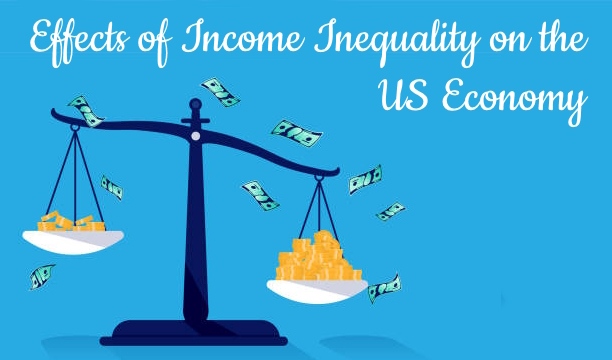Effects of Income Inequality on the US Economy
Income inequality has become an increasingly pressing issue in the United States. The gap between the rich and poor continues to widen, with the top 1% earning significantly more than the bottom 50%. This inequality has far-reaching effects on the US economy, from decreased economic growth to reduced social mobility.
The effects of income inequality on the economy can be seen in a number of ways. In this article, we will examine the various ways in which income inequality impacts the economy of the United States.

Table of Contents
- 1 Impacts of Income Inequality on US Economy
- 1.1 1. Decreased Economic Growth
- 1.2 2. Reduced Social Mobility
- 1.3 3. Higher Poverty Rates
- 1.4 4. Health Disparities
- 1.5 5. Political Instability
- 1.6 6. Decreased Innovation
- 1.7 7. Unequal Access to Education
- 1.8 8. Limited Consumer Spending
- 1.9 9. Increased Debt and Financial Instability
- 1.10 10. Inequality of Opportunity
- 2 Conclusion
Impacts of Income Inequality on US Economy
1. Decreased Economic Growth
When income inequality is high, economic growth can suffer. This is because low-income individuals have less purchasing power, which can lead to decreased demand for goods and services. For example, during the Great Recession, the US economy experienced sluggish growth due to high levels of income inequality.
2. Reduced Social Mobility
Income inequality can also limit social mobility, making it difficult for individuals to climb the economic ladder. Low-income individuals may lack access to education, job training, and other resources needed to advance their careers. For example, a study by the Brookings Institution found that upward mobility in the US has declined in recent years, particularly for those at the bottom of the income ladder.
3. Higher Poverty Rates
When income inequality is high, poverty rates tend to be higher. This is because low-income individuals may struggle to afford basic necessities, such as housing, healthcare, and food. For example, the poverty rate in the US has remained stubbornly high despite economic growth in recent years.
4. Health Disparities
Income inequality can also lead to health disparities, as low-income individuals may lack access to quality healthcare and nutritious food. For example, a study by the Centers for Disease Control and Prevention found that income inequality is a major predictor of health disparities in the US.
5. Political Instability
Income inequality can also lead to political instability, as individuals who feel left behind by the economy may become more likely to support extremist political movements. For example, the rise of populism in the US and Europe has been linked to high levels of income inequality.
6. Decreased Innovation
Income inequality can also lead to decreased innovation, as individuals from low-income backgrounds may lack access to the resources and education needed to pursue innovative ideas. For example, a study the National Bureau of Economic Research found that a lack of economic mobility in the US may be hampering innovation and entrepreneurship.
7. Unequal Access to Education
Income inequality can also impact education, as low-income individuals may struggle to afford quality education or have access to the same opportunities as their wealthier counterparts. For example, school funding is often tied to property taxes, which means that students in low-income neighborhoods may attend schools with fewer resources and less experienced teachers.
8. Limited Consumer Spending
When income inequality is high, consumer spending can be limited, as low-income individuals may have less disposable income to spend on goods and services. This can lead to decreased demand and slower economic growth. For example, a study by the Federal Reserve Bank of St. Louis found that low-income households tend to spend a larger portion of their income on necessities, such as housing and food, leaving less disposable income for discretionary spending.
9. Increased Debt and Financial Instability
Income inequality can also lead to increased debt and financial instability, as low-income individuals may be forced to take on debt to cover basic expenses or face economic shocks. For example, the 2008 financial crisis was in part fueled by high levels of household debt, particularly among low-income households.
10. Inequality of Opportunity
Income inequality can also lead to an inequality of opportunity, as low-income individuals may lack access to the same opportunities as their wealthier counterparts. This can include access to education, job training, and other resources needed to succeed. For example, a study by the Pew Research Center found that the income gap between high- and low-income households in the US has widened in recent decades, making it more difficult for low-income individuals to achieve upward mobility.
Conclusion
In conclusion, income inequality has a number of far-reaching effects on the US economy, from decreased economic growth to reduced social mobility and increased debt. Addressing income inequality will require a multifaceted approach that addresses education, job training, healthcare, and other social safety net programs. It will also require policies that aim to level the playing field and provide equal opportunities for all individuals, regardless of their income or background.
For example, policies such as raising the minimum wage, expanding access to affordable healthcare, and investing in education and job training programs can help reduce income inequality and promote economic growth. Additionally, targeted policies such as progressive taxation, which taxes higher income earners at a higher rate, can help reduce income inequality and provide more resources for social safety net programs.
In the long term, addressing income inequality is not only an issue of social justice, but also critical to sustaining economic growth and stability. As the US continues to grapple with this issue, it is important to recognize the many ways in which income inequality impacts the economy and to work towards policies that promote greater equality and opportunity for all.


